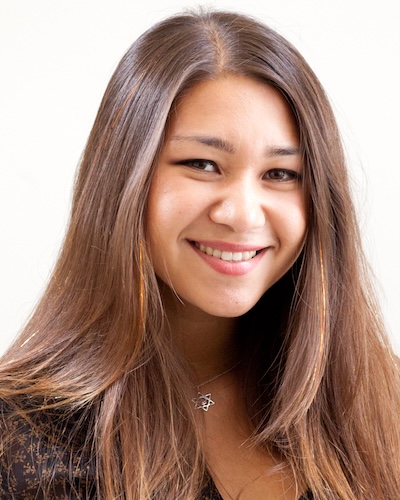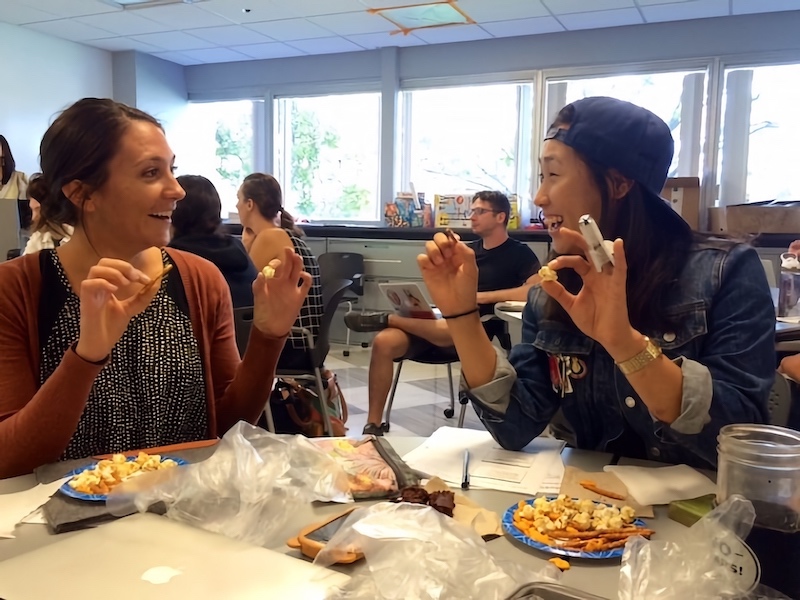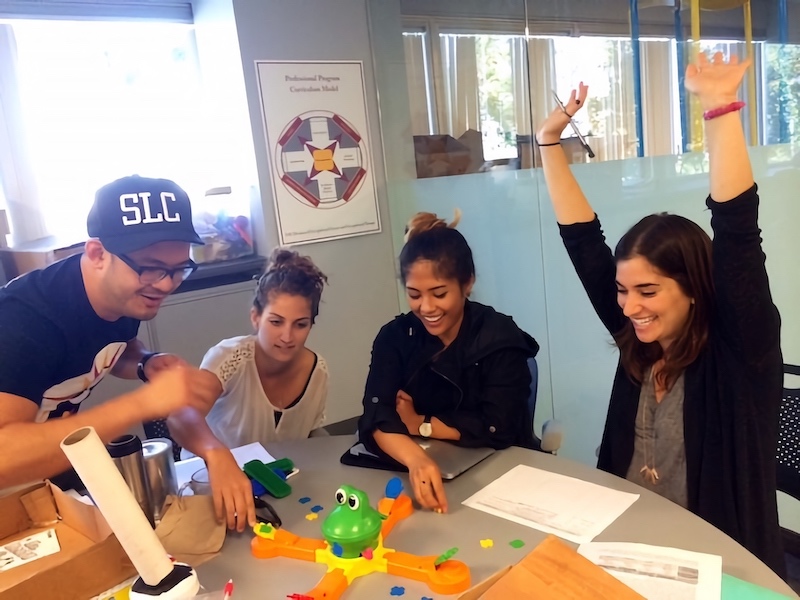Student Blog
Ariel

FUN with Hand FUNction! ⟩
September 17, 2015, by Ariel
Hello all! We learned some really awesome stuff in class this week, so I thought it might be neat to give you guys a taste of the ways our professors make our lessons come to life!
To give you a little background, I am currently completing my Pediatric Immersion. This means that I have six hours of lecture per week in Peds, which is accompanied by three hours of lab. I know it sounds like a lot of hours for one subject, but our enthusiastic teachers keep things fresh and exciting by incorporating hands-on (and tasty!) activities into our lectures and labs.
This week, we learned all about hand function — grasp development, fine motor control, and the ways that children experiencing difficulties with the use of their hands might benefit from strengthening exercises, compensatory strategies, and/or adaptive equipment in order to thrive.
One of the coolest things about occupational therapy is that to an outside observer, the activities we do with our pediatric patients might look just like play. But in graduate school, we’ve learned how to break down these specific activities (such as games) into their smallest components — a process called activity analysis — in order to develop our clinical reasoning skills. Ultimately, this will help us in practice when the time comes to assess our patients’ abilities, plan meaningful interventions, and understand the fundamental demands (mental, physical, environmental, and otherwise) required for a person to successfully complete any given task.
Here are some fun pictures of my classmates learning all about functional hand grasps!

Cohort A Learns Pincer Grip!
For this activity, our professor brought in all kinds of yummy snacks, and then demonstrated each type of hand grasp we were learning by talking us through each position as we manipulated our food. Above are two classmates demonstrating the pincer grasp. So . . . Why is pincer grasp important? Well I’m so glad you asked! Pincer grasp employs the thumb and index finger to pick up small objects. It is a key developmental milestone that allows children the ability to feed themselves early on. Later, it is incredibly important in completing childhood tasks such as holding pencils, using utensils, and fastening things like buttons on a shirt.

Cohort A Plays Hand Games!
For this activity, our teacher brought in tons of child-friendly games. As a group, we analyzed each to determine their age appropriateness and created descriptions of accompanying skills the game develops (such as fine motor, visual motor, or cognitive). We then connected these skills with real-life activities in which a child might need to engage throughout his or her day (e.g., dressing, writing, feeding, bathing). In the above photo, you’ll notice my classmates are playing Mr. Mouth, a game that requires participants to employ skills such as pincer grasp, scanning, attention, impulse control, and force gradation. While this might sound like a lot of fancy-schmancy words, in reality, building these fundamental skills will later allow the child to fully engage in social play, develop their impulses, and get around in their community.
If you haven’t realized by now, the way an occupational therapist can use activity analysis to deduce the therapeutic benefits of specific activities is pretty incredible!
⋯

Hello Lovely Readers! ⟩
August 27, 2015, by Ariel
Hello Lovely Readers!
For my first post, I’ve decided to mirror the student ambassadors of years past by telling you the tale of how I first fell in love with occupational therapy . . . .
Once upon a time . . .
I was a sophomore in college majoring in Comparative Studies in Race and Ethnicity (an interdisciplinary mix of psychology, sociology, anthropology, and history), and minoring in Drama. Despite this eclectic mix, somehow I wasn’t too concerned about what profession I would ultimately pursue; I figured if I took classes I was passionate about, they would lead to a major I was passionate about, which would eventually lead to a job I was passionate about. Then, in junior year, all my peers started siphoning off into various career tracks — tech, business, law, medicine, education . . . I knew I needed to do some major self-reflection and research to figure out which path I would take.
First, I thought about what I wanted out of my work: I knew I wanted to be in a helping role, create meaningful relationships, and that I wanted to wake up every morning (even 30+ years down the line) and still be energized by the path I had chosen. Second, I knew I wanted to have a flexible career — one that was dynamic in nature and broad enough that I could continuously be learning and expanding upon my knowledge. And third, I wanted to work in a profession that relied on kinesthetic experience (read: no cubicles!), and that would allow me to flex my creativity.
For a long time, I was unsure of how to proceed; even after hours of research (thanks Google!), it seemed that no profession existed that fulfilled all of my ideals in the way I had hoped. Then, during the last week of my senior year, I had a chance encounter with an acquaintance from my freshman dorm. She told me that she was going to graduate school for this profession called “occupational therapy,” and that if I wanted to help people I “should really check it out.” I had no idea at the time, but her offhanded comment would prove to be quite serendipitous. I headed back to Google, and searched for anything and everything related to occupational therapy. That’s when I fell down the rabbit hole . . . and I’ve just kept falling ever since.
Initially, it was the theory behind occupational therapy that was compelling: I was inspired by OT’s consideration of the multidimensional nature of the human experience. But it was in the clinic setting where I truly fell in love with the field.
My first hands-on experience with OT was at a pediatric occupational therapy clinic in San Francisco that helps children gain the strength and functional ability to overcome developmental challenges. Early on, I assisted a therapist in treating a boy with severe sensory processing disorder. At first, he was terrified to navigate the obstacle course, ride the zip-line, or even play with the toys. Over the course of several months, the OT and I graded his activities to address his sensory disorganization (a few terms you’ll learn in OT school!). His progress was astonishing. In time, the same boy whose frantic screams had once echoed down the hallways was beaming with confidence, showing off his fearless zip-lining skills. I could barely believe this was the petrified boy I had once met. I was thrilled to have taken part in his extraordinary transformation, and it was then that I knew for certain I would pursue occupational therapy.
Occupational therapy gives its recipients a new opportunity to really live. It was in my hands-on experiences where I concluded that the most serious adversities afford the most potent opportunities for growth. Furthermore, these experiences revealed to me that it is in grappling with our greatest physical and emotional challenges that we discover not only our limitations but — more importantly — our innate resilience.
Here at USC’s number one ranked program in Occupational Science and Occupational Therapy, I’ve been offered so many different opportunities: I’ve been given the opportunity to teach children new skills, mentor adults and adolescents in attaining life goals, help brain injured patients maintain independence, explore research that advances evidence-based practice, and learn the ins and outs of creating community programs. Above all, USC’s occupational therapy program is preparing me to reach my overarching goal: emboldening patients to discover within themselves the perennial strength of the human spirit.
Welcome to my blog, and FIGHT ON!!!
⋯





